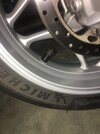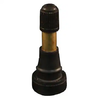You are using an out of date browser. It may not display this or other websites correctly.
You should upgrade or use an alternative browser.
You should upgrade or use an alternative browser.
Transforming IGOFARs ST1300 . . . to Shuey's!
- Thread starter Shuey
- Start date
Most shops are required to replace the valve stem at every tire change, and as long as you use a good quality SHORT stem, I've never had one of them (Michelin) fail.You don't want a rubber valve stem, they will crack/ break.
I have seen many aftermarket Metal stems fail when the rubber O-rings crack and come apart. And nobody seems to support the metal stem O-rings etc.
Just a thought.
Shuey
Site Supporter
Because, I'd like to know there's a problem . . . before the shimmy. Maybe it's just me.Why would you need a monitor system to tell you, when the "shimmy" should have been obvious enough
Shuey
As far as the TPMS sensor, I'd use a quality metal valve such as:
A 90* version: https://www.wunderlichamerica.com/M...1cZiUut-zIyZ2xOnmrAOWrqPXhRGSJBAXr8NdVzR33PPi
or
A metal "T"-valve, that makes adding air very simple: https://wingstuff.com/products/37222-t-valve-optional-accessory-for-fobo-2-tpms
A 90* version: https://www.wunderlichamerica.com/M...1cZiUut-zIyZ2xOnmrAOWrqPXhRGSJBAXr8NdVzR33PPi
or
A metal "T"-valve, that makes adding air very simple: https://wingstuff.com/products/37222-t-valve-optional-accessory-for-fobo-2-tpms
Shuey
Site Supporter
Whaaaaat . . . no lights on the rear wheel or center stand? That's just embarrassing.And what is your exact goal with your Pan?
Something like this Goldwing?
Shuey
Very common in high pressure tires.
The TPMS system will start to warn you when you lose as few as 3-4 lbs. Plenty of time to assess the problem BEFORE the shimmy. Been there, done that.Because, I'd like to know there's a problem . . . before the shimmy. Maybe it's just me.
Shuey
Last edited:
Excellent write up, Shuey. I just bought this and am looking forward to riding it this weekend. If I could have custom/personally ordered a long distance Touring bike, it would have looked exactly like this as long as it wasn't me doing the awesome work.
I like TPMS too and install them more or less immediately on a new-to-me bike. With new or newer tires I don't wait until a tire change but take the cap off a Sharpie marker and cut it to the length that matches the distance from rim to underside of the sensor thus making a compression tube that keeps the valve stem in column. Sharpie caps are just the right diameter to fit over the base of the stem.Absolutely. Replacement stems are already in hand . . . and will be installed next tire change.
Shuey

Guys changing their own tires or tires for a friend might not install a new stem every tire change. I'm curious as to the failure mode of the O-rings that you have seen and the type of metal valve stem using them.Most shops are required to replace the valve stem at every tire change, and as long as you use a good quality SHORT stem, I've never had one of them (Michelin) fail.
I have seen many aftermarket Metal stems fail when the rubber O-rings crack and come apart. And nobody seems to support the metal stem O-rings etc.
Just a thought.
The type shown in post #147 are same or similar to the ones I install, the 87 degree aluminum billet stems. The exterior part of the valve stem has a groove the O-ring sits in. It's not really an O-ring, in cross section it's more of an L. The nut has a machined section above the flats with the OD closely fitting the ID of the groove. When the nut is run up against the rim and tightened it compresses the O-ring into the groove while pressing it against the opening in the rim. It cannot come out of the groove or rim when assembled. It cannot crack and come apart while the nut and rim are compressing it. Conceivably the rubber O-ring could harden over time and develop a slow leak but it wouldn't be a catastrophic failure. I've run them as long as 150-160,000 miles in a wheel w/o any problem. Because of the fail safe design it has more integrity than a rubber stem with a grommet base.
A dickie (fake turtle-neck).
Guys changing their own tires or tires for a friend might not install a new stem every tire change. I'm curious as to the failure mode of the O-rings that you have seen and the type of metal valve stem using them.
The type shown in post #147 are same or similar to the ones I install, the 87 degree aluminum billet stems. The exterior part of the valve stem has a groove the O-ring sits in. It's not really an O-ring, in cross section it's more of an L. The nut has a machined section above the flats with the OD closely fitting the ID of the groove. When the nut is run up against the rim and tightened it compresses the O-ring into the groove while pressing it against the opening in the rim. It cannot come out of the groove or rim when assembled. It cannot crack and come apart while the nut and rim are compressing it. Conceivably the rubber O-ring could harden over time and develop a slow leak but it wouldn't be a catastrophic failure. I've run them as long as 150-160,000 miles in a wheel w/o any problem. Because of the fail safe design it has more integrity than a rubber stem with a grommet base.
I guess I could be a great example of someone changing (lots) tires and not the valve stems. When Byron and I were changing out my tires when I was commuting, I was changing out tires every three to four months, since I was doing anywhere from 28K to 32K miles every year. I put in the 90degree stems and never gave them a second thought and never had any fail on me.
And since Byron moved away, I started changing my own tires (when I bought a No-Mar tire changer from Mike, around October 2016) and still haven't had a valve stem fail me that were installed a VERY LONG time ago!
I can't even remember when I installed them on my 2004.
Come to think of it, I even put them in my first 2005, that I sold Justin with 174.3K miles on it, and he has over 190K miles now and still has the same valve stems.
Dave,I like TPMS too and install them more or less immediately on a new-to-me bike. With new or newer tires I don't wait until a tire change but take the cap off a Sharpie marker and cut it to the length that matches the distance from rim to underside of the sensor thus making a compression tube that keeps the valve stem in column. Sharpie caps are just the right diameter to fit over the base of the stem.
What brand TPMS do you use?
While most valve stem failures are never catastrophic, I have a jar somewhere with a couple dozen of ones that "failed" and constantly leaked air.Guys changing their own tires or tires for a friend might not install a new stem every tire change. I'm curious as to the failure mode of the O-rings that you have seen and the type of metal valve stem using them.
The type shown in post #147 are same or similar to the ones I install, the 87 degree aluminum billet stems. The exterior part of the valve stem has a groove the O-ring sits in. It's not really an O-ring, in cross section it's more of an L. The nut has a machined section above the flats with the OD closely fitting the ID of the groove. When the nut is run up against the rim and tightened it compresses the O-ring into the groove while pressing it against the opening in the rim. It cannot come out of the groove or rim when assembled. It cannot crack and come apart while the nut and rim are compressing it. Conceivably the rubber O-ring could harden over time and develop a slow leak but it wouldn't be a catastrophic failure. I've run them as long as 150-160,000 miles in a wheel w/o any problem. Because of the fail safe design it has more integrity than a rubber stem with a grommet base.
You mention close fitting, run up against the rim, tightened, compresses against the rim, etc. But our comment "it cannot crack and come apart while the nut and rim are compressing it" is incorrect in my experience. It's rubber and can get hard and deteriorate. You're forgetting about the heat cycles inside the tire assembly.
Just like life support, rubber can fail.
I even have a few of the one's like in post #147 that got hard and leaked.
So, despite your usual "I've run them XXX,XXXX miles" as with any part/item you favor, just because you have not seen it, does not mean it does not happen.
And it's quite possible, that most folks, are totally unaware of these small/minor leaks, and think everything is wonderful for XXX,XXXX

I started with the Tire Gard and switched to the SYKIK 300 TPMS system when they appeared on Amazon. SYKIK is fully waterproof and the Tire Gard was replaced once when the display got wet. I used to carry little plastic bags to cover it in wet weather.Dave,
What brand TPMS do you use?
Share:



